area books will be added here.
VISTABOOKS HISTORY REPRINTS--
Mariposa Museum (CA)_
(in stock: for quantity orders, go to vistabooks.com):
also available on ebay and ebid
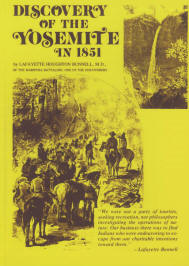 DISCOVERY OF THE YOSEMITE IN 1851 (CA). by Lafayette Houghton Bunnell, M.D., one of the Discoverers, of the Mariposa Battalion.
DISCOVERY OF THE YOSEMITE IN 1851 (CA). by Lafayette Houghton Bunnell, M.D., one of the Discoverers, of the Mariposa Battalion.
First published in 1880, this is the primary account of how Yosemite Valley came to be
"discovered" by the white race. Of course, the Indians knew it was there; they
were living in it when the battalion came to roust them out. The valley had been seen from
its rims and from afar before this trip, but this was the first recorded entry and
exploration. Bunnell proposed the name of the Indian tribe for the valley, "as it was
suggestive, euphonious, and certainly American; that by so doing, the name of the tribe of
Indians which we met leaving their homes in this valley, perhaps never to return, would be
perpetuated." Foreword by former chief park naturalist William R. Jones. Period engravings. 184pages, slightly abridged from the original. See sample pages, illustrations.
ISBN-10: 0-89646-021-5.
ISBN-13: 978-0-89646-021-8. Order #: VIST0021 paper$6.95.
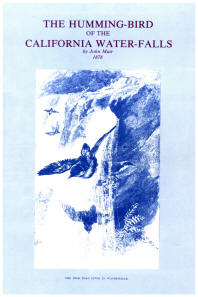 THE HUMMINGBIRD OF THE CALIFORNIA WATERFALLS. by John Muir.
THE HUMMINGBIRD OF THE CALIFORNIA WATERFALLS. by John Muir.
Reprinted from 1878. This has been called "the finest bird biography ever
written". Muir's "waterfall hummingbird" is the water-ouzel, of course, now
also called the dipper. Although Muir buffs and birders already know this, even they will
enjoy reading or re-reading the story of this little bobber. Some might have seen this
little bird, but without this article have not yet enjoyed the flier/swimmer fully. As
Muir's portrayal shows, much of the bird's intrigue is its physical elusiveness while
remaining visually accessible. Enjoy this little story and enjoy this little bird.
Foreword by former Chief Park Naturalist, Yosemite National Park. Period illustrations. 24 pages. See sample pages, illustrations.
ISBN-10: 0-89646-019-3.
ISBN-13: 978-0-89646-019-5. Order #:
VIST0019 paper$3.95.
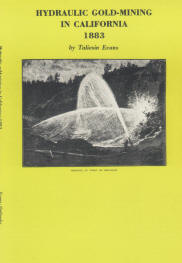 HYDRAULIC GOLD-MINING IN CALIFORNIA, 1883. by Taliesin Evans.
HYDRAULIC GOLD-MINING IN CALIFORNIA, 1883. by Taliesin Evans.
By the 1870s and 1880s in the California gold country, the gold that had been easy to
pick up already had been. But there was lots more, buried in the earth. A massive plumbing
system was built to harness water as a tool to wash the earth away and leave a residue of
heavy metals, especially gold. Meanwhile, though, mud and gravel released in the process
washed downstream to inundate farms and homes. Dwellers there objected, and in court they
effectively stopped the hydraulic mining--one of the earliest environmental court actions.
But when our author was there, his interest was describing a vital western industry. And
the mines can still be seen--Interstate Highway 80 runs right through one at Gold Run, and
another is the Malakoff Diggings State Historical Park, where you can not only see the
washed banks but also some of the nozzles and mining equipment used to get the gold out.
Reprinted from 1883. Illustrations are from the original article and other period sources. See sample pages, illustrations.
ISBN-10: 0-89646-052-5.
ISBN-13: 978-0-89646-052-2. 16 pages. Order #: VIST0052 paper $3.95.
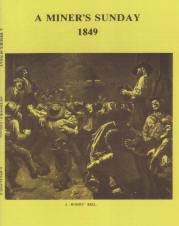 A MINER'S SUNDAY, 1849. by Charles B. Gillespie.
A MINER'S SUNDAY, 1849. by Charles B. Gillespie.
This story is set in Coloma, the California gold discovery site of 1848. But it might have happened at any of the gold-rush sites of the West--Virginia City, Cripple Creek, the Klondike--and it probably did, but only on Sunday. Town was a lively place the one day the mines were shut down, with a mix of nationalities engaging in gambling, auctions, horse-racing, shopping for clothes and supplies, eating, drinking, brawling, and general tom-foolery as you might expect from a bunch of young men from all over the world who were off to a get-rich adventure. Illustrations are from early sources, including the original article of 1891, Frederic Remington, and the Crocker Art Museum. 16 pages. See sample pages, illustrations.
ISBN-10: 0-89646-005-3. ISBN-13: 978-0-89646-005-8. Published by VistaBooks 1981. Order #: VIST0005 paper$3.95.
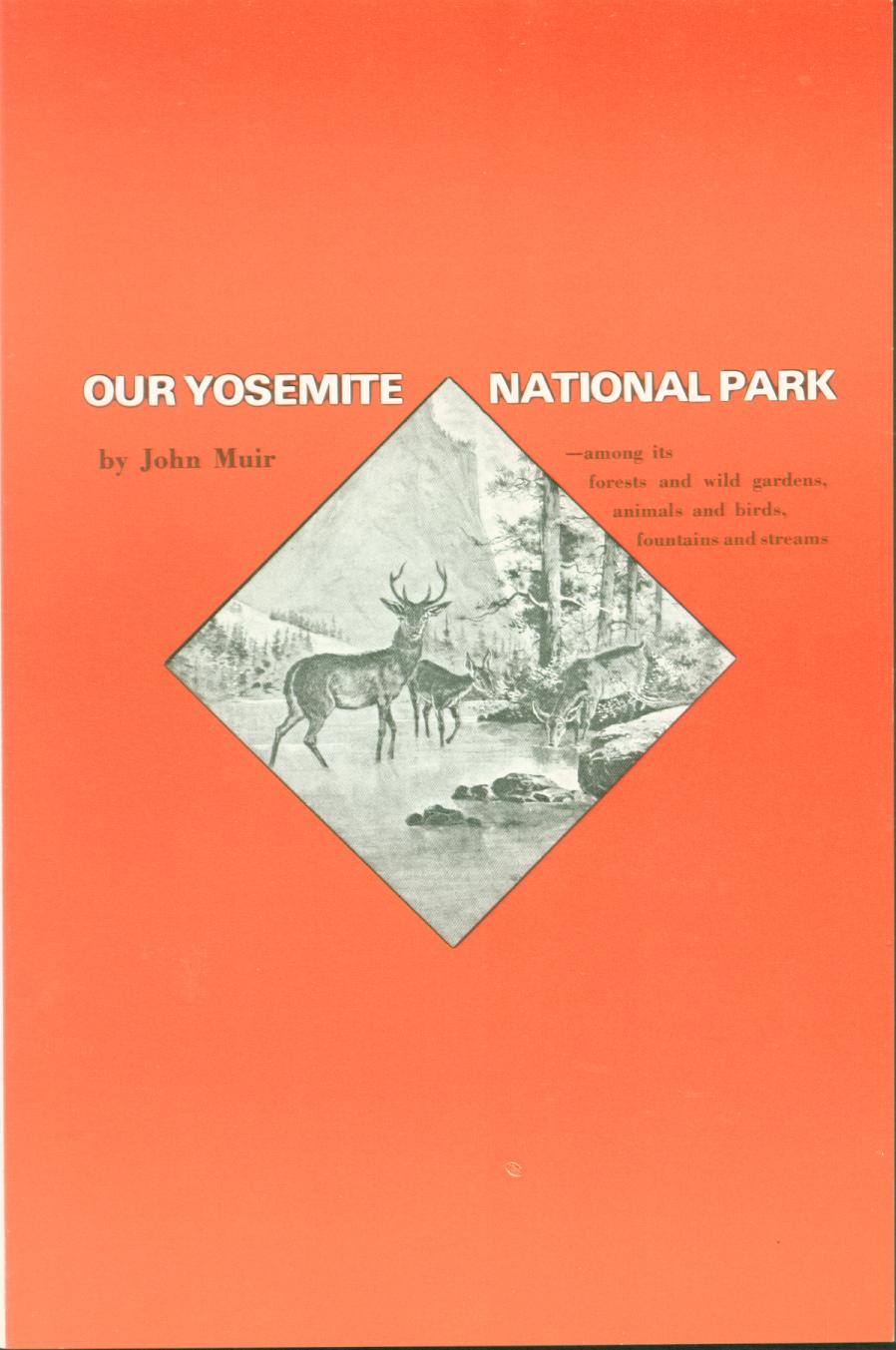 OUR YOSEMITE NATIONAL PARK (CA). by John Muir.
OUR YOSEMITE NATIONAL PARK (CA). by John Muir.
Among its forests and wild gardens, animals and birds, fountains and streams. At the
turn of the century, John Muir described Yosemite National Park to readers of The
Atlantic Monthly in the articles here reprinted. Just a decade before he had been so
involved with the park idea that he became known as the "father of Yosemite National
Park". Muir knew the park better than anyone else, and he had a gift for expression
that keeps his fame and his works alive yet. The writing here is perhaps the best blend
Muir gave of the Yosemite as a wild nature preserve. The ecological account is full, and
we learn much of Muir's observations of the Yosemite birds, bears, and blossoms as well as
its winters, earthquakes, glaciers, and forests. Period illustrations. 96 pages. See sample pages, illustrations.
ISBN-10: 0-89646-061-4.
ISBN-13: 978-0-89646-061-4. Order #: VIST0061 paper$6.95.
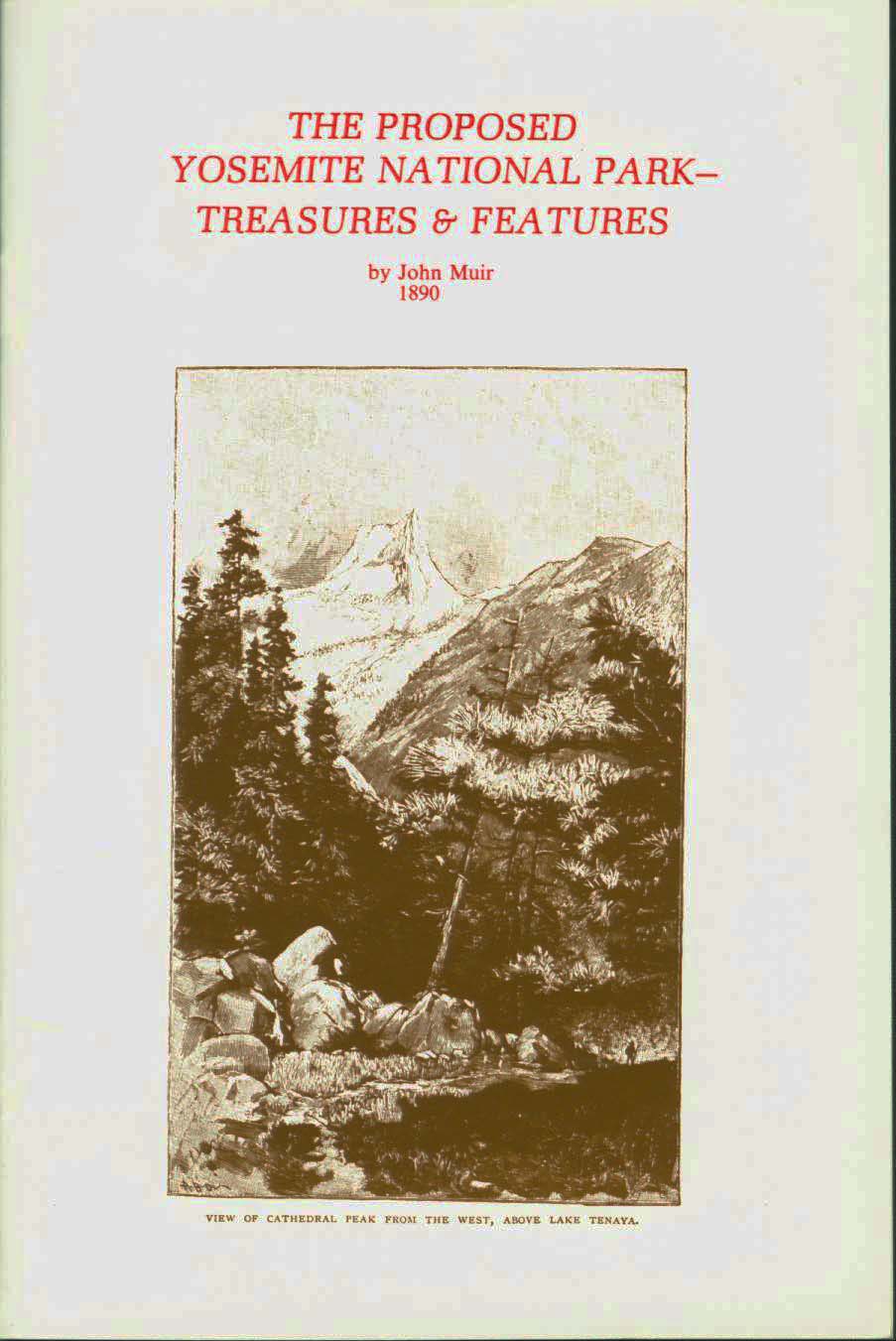 THE PROPOSED YOSEMITE NATIONAL PARK--treasures & features, 1890 (CA). by John Muir.
THE PROPOSED YOSEMITE NATIONAL PARK--treasures & features, 1890 (CA). by John Muir.
Perhaps the most important writing Muir ever did, for here he proposed a national park,
which was soon established. He and his editor had hatched the scheme around a Tuolumne
Meadows campfire, and so Muir became known as the "Father of Yosemite National
Park." The writing is mostly descriptive, in Muir's magnificent style, covering the
grand scenes, waterfall explorations, storm flooding, sequoias, glaciers, Hetch Hetchy
Valley, and more. An included map shows Muir's proposed park boundaries, larger than
today's, as one might imagine, for there was controversy about taking too much mineral
land from potential production. Also shown is the watershed of the Yosemite Valley, as a
major purpose of the new park was to protect the waterfalls of Yosemite Valley from
upstream lumbering and sheep-grazing. At that time, Yosemite Valley was under state
operation and the new park would not affect that; later, however, the valley was returned
to federal management and the present park achieved its wholeness. Foreword by former
Yosemite Chief Park Naturalist William R. Jones. Reprinted from 1890, with period engravings. 32 pages. See sample pages, illustrations.
ISBN-10: 0-89646-003-7.
ISBN-13: 978-0-89646-4. Order #: VIST0003 paper$3.95.
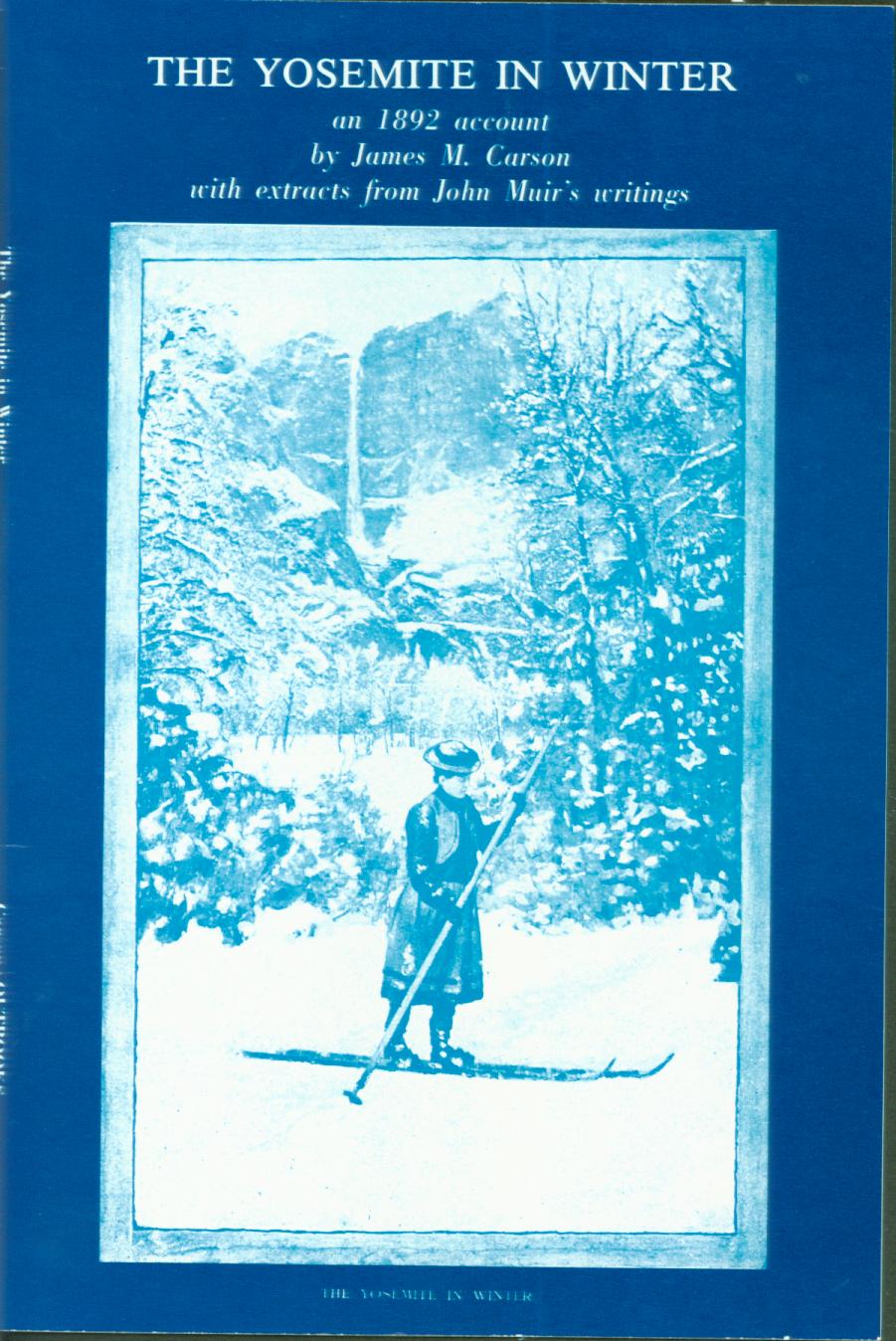 THE YOSEMITE IN WINTER:
an 1892 account (CA). by James M. Carson, with extracts from John Muir's writings.
THE YOSEMITE IN WINTER:
an 1892 account (CA). by James M. Carson, with extracts from John Muir's writings.
An appreciation of Yosemite Valley's winter character and an early history of the first
winter residents, with passages from John Muir, who also was a year-round
valley resident in the early days. Reports of floods, in which trees were swept over the
waterfalls, of the ice-cone at the base of Upper Yosemite Fall, snow-banners flying off
rangecrest peaks, use of "snowshoes" (skis, today) to bring in the mail,
winter-time climatic differences between north and south sides of this deep east-west
trending valley due to shadows. Foreword by former Yosemite Chief Park Naturalist William R. Jones. Period engravings. 16 pages. See sample pages, illustrations.
ISBN-10: 0-89646-053-3.
ISBN-13: 978-0-89646-053-9. Order #:
VIST0053 paper$3.95.
Click for more VistaBooks History Reprints
END OF "Mariposa Museum (CA)" PAGE--click
For discounts of 50-90% on related titles click VistaBooks Outlet
click ![]() for "Home/Contents" or use links in sidebars
for "Home/Contents" or use links in sidebars
click for "Forests/StateParks/Museums"
This VistaBooks Encore "Mariposa Museum (CA)" page last revised December 2, 2023. Did you come here from a link on another website? For latest version of this page, click or copy to your browser: https://www.vistabooksencore.com/pages/vbe1fspmamu.html. Copyright © 2023 VistaBooks LLC.
Need help? email. We want you to find what you want to find.
Thanks for looking!